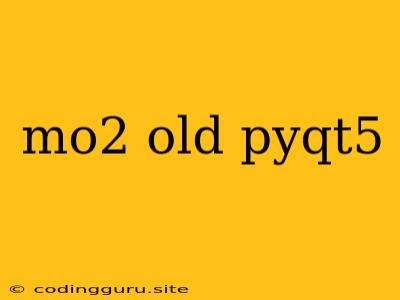What is MO2 and PyQt5?
MO2, or Mod Organizer 2, is a popular modding tool for Bethesda games, particularly Skyrim and Fallout 4. It provides a streamlined way to manage and organize mods, reducing conflicts and making it easier to experiment with different combinations. PyQt5, on the other hand, is a Python binding for the Qt framework, offering a powerful toolkit for creating graphical user interfaces (GUIs).
Why Use MO2 with PyQt5?
While MO2 is already a well-equipped tool, there are reasons why you might want to integrate PyQt5 to enhance its functionality. Here are some potential benefits:
- Customizing the User Interface: PyQt5 allows you to create custom widgets, dialog boxes, and layouts, giving you more control over how MO2 looks and feels. You can tailor it to your preferences and workflow.
- Extending Functionality: PyQt5 provides access to a vast library of widgets and functions, enabling you to add new features to MO2, such as automated mod installation scripts, custom mod management tools, or even integration with other applications.
- Scripting Automation: With PyQt5, you can create scripts to automate repetitive tasks within MO2. Imagine automating mod installations, backups, or even creating mod profiles.
Getting Started with PyQt5 and MO2
Here's a basic guide to get you started with integrating PyQt5 into MO2:
- Install PyQt5: First, ensure you have PyQt5 installed. You can usually install it using pip:
pip install PyQt5 - Understanding MO2's Structure: MO2 has an API (Application Programming Interface) that allows interaction with its internal workings. You'll need to familiarize yourself with this API to understand how to connect PyQt5 to MO2.
- Creating a PyQt5 Application: Use PyQt5 to build a basic application that connects to MO2's API. This will involve creating a window, adding widgets, and writing code to interact with MO2's functionality.
Example: Adding a Custom Button to MO2
Let's illustrate a basic example: adding a button to MO2 that performs a specific action when clicked.
import sys
from PyQt5.QtWidgets import QApplication, QWidget, QPushButton
from PyQt5.QtCore import QThread, pyqtSignal
# This is just a placeholder for your actual MO2 API interaction
class MO2Manager:
def perform_custom_action(self):
# Replace this with your actual MO2 function call
print("Custom action performed!")
# Create a new PyQt5 window
class CustomWindow(QWidget):
def __init__(self):
super().__init__()
self.setWindowTitle("Custom MO2 Button")
self.button = QPushButton("Perform Custom Action", self)
self.button.clicked.connect(self.on_button_click)
self.layout = QVBoxLayout(self)
self.layout.addWidget(self.button)
def on_button_click(self):
# Create a worker thread to interact with MO2 (to avoid freezing the UI)
thread = QThread()
self.mo2_manager = MO2Manager()
self.mo2_manager.moveToThread(thread)
thread.started.connect(self.mo2_manager.perform_custom_action)
thread.finished.connect(thread.deleteLater)
thread.finished.connect(self.mo2_manager.deleteLater)
self.button.clicked.connect(thread.start)
if __name__ == "__main__":
app = QApplication(sys.argv)
window = CustomWindow()
window.show()
sys.exit(app.exec_())
This simple example demonstrates how you can create a custom button that calls a function within MO2's API. You would replace the placeholder MO2Manager and perform_custom_action with your actual MO2 API interaction.
Tips for Working with MO2 and PyQt5
- Thorough API Documentation: Familiarize yourself with MO2's API documentation to understand the available functions and how to use them.
- Use Threading: When performing actions that might take time (like installing mods), use threading to avoid freezing the PyQt5 GUI.
- Handle Exceptions: Implement error handling to gracefully deal with potential issues when interacting with MO2's API.
- Test Thoroughly: Test your PyQt5 application extensively to ensure it interacts correctly with MO2 and functions as expected.
Conclusion
Combining MO2 with PyQt5 opens up a world of possibilities for customizing and extending the modding experience. By leveraging PyQt5's GUI capabilities and MO2's API, you can build powerful tools to enhance your modding workflow and tailor MO2 to your specific needs. Remember to start with clear goals, thoroughly learn the API, and test your applications carefully for a smooth and enjoyable experience.
